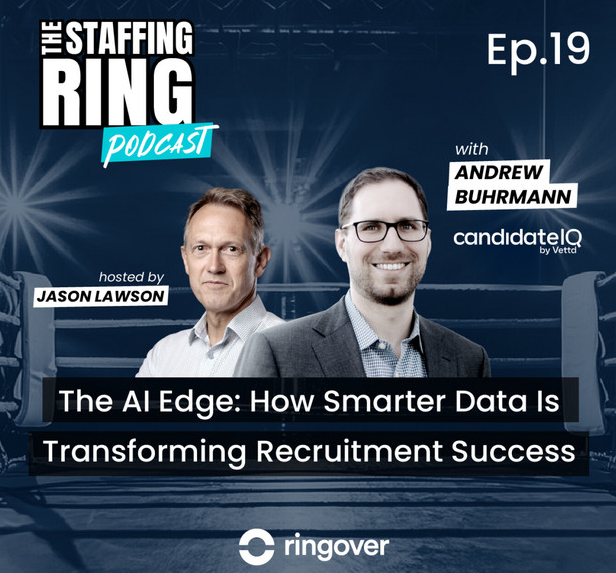"Poor data quality is the biggest barrier to adopting automation and AI effectively. Without clean data, automation becomes less impactful and leads to frustration." – Joe Calzone, VP of Front Office
If there was one takeaway from our recent Data Strategy Webinar, it’s this: data quality isn’t just a technical issue—it’s a revenue issue. Whether you’re trying to improve recruiter efficiency, enhance marketing performance, or leverage automation and AI, bad data can silently kill your results.
With 2025 on the horizon, now is the time to take control of your candidate database, optimize your processes, and build a foundation for success. This blog recaps the key insights from the webinar and outlines a step-by-step plan to future-proof your data strategy.
The Reality of Candidate Data Dysfunction
Most staffing firms know they have data issues, but the scale of the problem is often underestimated. Andrew Buhrmann, co-founder and CEO of CandidateIQ, noted that less than 10% of staffing databases have fully complete, reliable candidate records.
That means recruiters spend hours per week correcting data instead of engaging with candidates. Marketing teams waste resources on email campaigns that bounce. Automation workflows stall because of incomplete profiles.
The problem compounds itself:
- Recruiters skip fields due to a lack of trust in the system.
- Marketing campaigns underperform due to invalid emails and phone numbers.
- AI and automation efforts fail because they rely on structured, accurate data.
"Data quality issues act as silent productivity and opportunity killers. Cleaning up these issues is crucial for recruiter performance and business outcomes." – Andrew Buhrmann
The Vicious Cycle of Bad Data
One of the most eye-opening discussions in the webinar was how bad data creates a feedback loop of inefficiency:
- A recruiter searches for candidates but finds incomplete or outdated records.
- They move to external sources like LinkedIn, Google, or job boards.
- They manually enter updated information—but inconsistently.
- Over time, duplicate and mismatched records accumulate, making future searches even harder.
- Recruiters lose trust in the system, relying on manual processes instead.
The result? More time wasted, fewer placements made, and higher operational costs.
"Bad data creates a vicious cycle where recruiters distrust the system and resort to manual processes, further degrading data quality." – Erin MacKenzie, VP of Client Services
A 2025 Data Strategy: Five Key Steps
The good news? Fixing candidate data isn’t impossible—it just needs structure and the right approach. Here’s the five-step strategy discussed in the webinar to regain control over your database.
1. Evaluate Your Database Health
Before making any changes, know where you stand. A data health check should:
✔ Identify incomplete records, duplicates, and outdated information.
✔ Focus on high-impact fields like email addresses, phone numbers, and job history.
✔ Benchmark your search speed, time-to-hire, and duplicate percentages.
"Assign your database a grade. Define improvement goals based on where you are today." – Andrew Buhrmann
2. Clean and Enrich Your Data
Once you’ve identified problem areas, the next step is cleaning and enriching your records:
✔ Remove or consolidate duplicate profiles.
✔ Standardize job titles, skills, and contact formats.
✔ Use automated enrichment tools to fill gaps in candidate records with missing skills, certifications, and work history.
"Improved profiles reduce recruiter time spent on data corrections and enable faster placements." – Joe Calzone
3. Implement Smart Automations
With a clean database, automation becomes an accelerator rather than a roadblock:
✔ Set rules-based triggers to automate follow-ups, interview reminders, and candidate updates.
✔ Normalize and categorize job titles and skills dynamically.
✔ Ensure automation tools work with clean data to prevent errors in outreach and engagement.
4. Standardize Skills & Taxonomy
✔ Define a clear skills taxonomy to simplify searches and improve matching accuracy.
✔ Normalize job titles and categories so recruiters and AI tools can work seamlessly.
✔ Use parsing tools to eliminate variations in how skills are listed across resumes.
"Standardizing skills ensures recruiters can search and match candidates more effectively." – Andrew Buhrmann
5. Continuously Improve & Train Your Team
✔ Develop Standard Operating Procedures (SOPs) for data entry.
✔ Train recruiters and marketers on how to maintain data quality within Bullhorn.
✔ Use performance metrics to measure progress over time.Data quality isn’t a one-time fix—it’s an ongoing process.
How Newbury and CandidateIQ Can Help
Now that we’ve outlined the path to better data, here’s where Newbury and CandidateIQ come in to execute these strategies at scale.
Newbury’s Expertise
- Data Health Audits: Identify data gaps, duplicates, and inconsistencies.
- Process Optimization: Implement structured workflows for ongoing data quality.
- Automation Strategy: Set up Bullhorn automation for better efficiency.
CandidateIQ’s Solutions
- Full-Service Data Quality Management: Automate enrichment and cleansing directly in Bullhorn.
- Database Enrichment: Populate missing skills, certifications, and work history.
- High-Volume Processing: Update thousands to millions of records, saving recruiters thousands of hours annually.
Planning for 2025: Next Steps
Here’s what you can do today to take action:
✅ Run a data health report on your Bullhorn database.
✅ Deduplicate records to reduce clutter and improve searchability.
✅ Enrich 1,000 candidate profiles using CandidateIQ for immediate impact.
✅ Host a team training session on data hygiene and automation.
Long-term goals:
✔ Assign a Data Quality Champion within your team.
✔ Conduct quarterly audits to track data improvement.
✔ Build a 2025 roadmap focused on automation and enrichment strategies.
Final Thought
"Data quality is the backbone of an effective recruitment system. Fix it, and everything else—automation, AI, recruiter efficiency—falls into place." – Erin MacKenzie
By committing to data quality today, you’re laying the foundation for higher placements, faster recruiting, and a competitive edge in 2025.
Ready to get started? Newbury and CandidateIQ are here to help.
Email us if you have questions or need advice on where to start:

Joe Calzone | Newbury Partners | VP, Front Office Practice
joe.calzone@newburypartners.com

Erin MacKenzie | Newbury Partners | VP, Client Services
erin.mackenzie@newburypartners.com

Andrew Buhrmann | CandidateIQ by Vettd.ai | Co-Founder, CEO
andrew@vettd.ai




